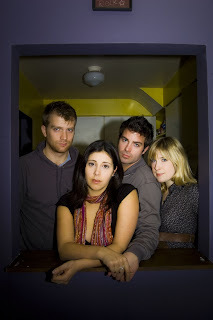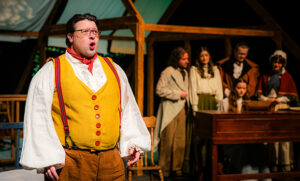andrew church, michelle langille, jason matheson, alison mackay
There are certain plays that, when performed well, seem like particularly good launching pads for people who don’t regularly attend the theatre. These productions are immensely valuable because they manage to find a precarious balance between evoking a resemblance to popular film or television, while still managing to capture the theatrical essence which is so unique and vital to the stage. The Volition Theatre Co-op’s production of Neil LaBute’s play The Shape of Things (2001), playing until Sunday March 7th, 2010 at the DeLeon White Art Gallery, is one such production. I would encourage all my theatrically savvy readers to attend this show with someone who, perhaps, swore off plays when he or she became royally baffled by Troilus and Cressida or bored by Major Barbara. LaBute may be just the impetus needed to shake out certain dusty old concepts of “theatre.”
Neil LaBute is an incredibly skilled writer who brilliantly uses the theatre as a means of presenting debates and constant opposing, overlapping, volatile and contradictory perspectives tightly and seamlessly woven into a fascinating and ultimately disturbing tale about characters that are rich in their idiosyncrasies and deficiencies, gripping in their ordinariness, and often simultaneously entrancing and deplorable. The Shape of Things is ultimately about the power of persuasion and our society’s obsession with the pursuit of physical perfection. LaBute hinges The Shape of Things on a dramatic twist at the end, a perversion of the story of Pygmalion, which calls into question the nature of art and the artist’s place in the world. What are the consequences of “art” being created “at any cost”? Is the price ever too high and who decides? Creation and destruction, subjectivity and morality, art and life, LaBute makes the lines between each one both ambiguous and provocative.
Director David Tompa places this production of The Shape of Things, a play so saturated with art, in a contemporary art gallery, and a different painting done by a local artist is hung as a backdrop for each scene. The choice of location is a perfect one for the ambiance suits LaBute’s style and tone and provides great intimacy for an audience snugly convened between long white curtains, focused directed at all times toward the four performers. One could study the works of art chosen in depth, I’m sure, and reflect on correlations in theme and style between the painting and its corresponding scene. Without focusing too exclusively on the art, however, I was acutely aware of how natural each piece seemed to be within its environmental context of the play. Tompa’s concept never seemed forced and all the paintings added a vibrant shot of color to the drab whiteness of the space. R.J. Peters’ set is remarkably simple, yet magically versatile. Throughout the play I was continually so impressed with how inventive Peters had been in creating the most professional set and lighting for his cast as possible from the resources available to him.
Tompa’s cast is uniformly impressive. Jason Matheson gives a particularly fantastic performance as Adam, an awkwardly timid, dorkily endearing, horrifically insecure self-described “English Lit prick” who allows himself to be guided by the whims of his girlfriend, Evelyn. Evelyn is played by Michelle Langille and she is undeniably the most convoluted character in the play. Langille’s performance is an impressive one, particularly when Evelyn is spewing her impassioned philosophies about art. She gives this brilliant lecture which captures an unsettling coldness and detachment in Evelyn perfectly. I wish that the run of this play were a longer one because I think that with more time Langille would have the opportunity to discover even more depth to this epic onion of a woman, depth which I think would especially enrich Evelyn’s relationships with the other characters. I wanted Evelyn to have a bit more fierceness and bite to her and for there to be an urgent sense of crispness in her dialogue with Adam, as though she were always waiting to pounce. Her iciness, however, was acute enough to freeze a fish. Andrew Church was bitingly funny as Philip, Adam’s fun-loving and adventuresome best friend who spends the entire play deflecting and repressing his reservations about taking the plunge and marrying his girlfriend Jenny. Church is excellent at releasing Philip’s emotions in the most controlled and covert ways emphasizing how hollow even communication between friends can be and how delicately intimacy hangs in this balance. Alison MacKay plays sensitive Jenny, a girl bursting with heart and struggling with her own feelings of inadequacy. MacKay is especially poignant in a scene near the end of the play with Langille and Matheson which is heart breaking to watch. Her chemistry with Matheson is absolutely lovely.
In all, The Volition Theatre Co-op have presented an invigorating piece of theatre with The Shape of Things and one that not only brings a strong script certain to incite discussion to Toronto, but also in proving that these young, vibrant theatre artists are willing to tackle rich, meaty material and they are able to bring this story to life with integrity and skill. I know that in the doing of such a play these performers will be learning innumerable critical lessons with each performance that they will carry with them beyond the run of this show. I am fascinated to see what comes from this group next.
The Shape of Things is going to sell out its run because space is extremely limited, so I would urge you all to email to reserve your space right away- The Shape of Things runs at 8pm Thursday to Sunday, March 7th, 2010 at the DeLeon White Art Gallery (1139 College Street- West of Dufferin). Tickets are $15.00. Email: volitioncoop@gmail.com before it sells out!







